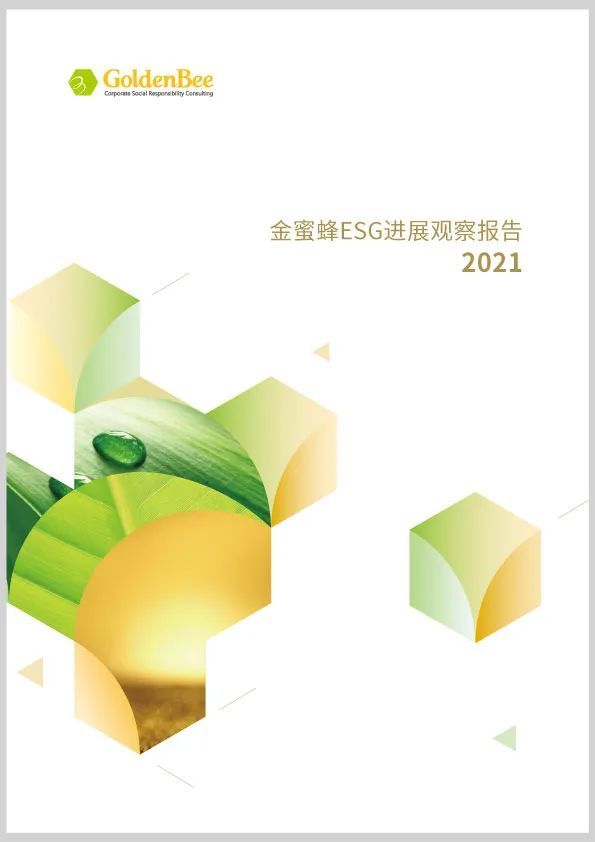
English | 中文

Carbon disclosure ushers in a window period
source:goldencsr date:2021-09-30 17:06:00
From the global economic recovery and inclusive growth in the post COVID-19 period, to the achievement of the Sustainable Development Goals (SDGs) by 2030, with the introduction of the China's “30·60” decarbonization goal, sustainable development has become the mainstream of global development. In China, the ESG investment philosophy and the transformation of company management are being further developed with the participation of stakeholders such as regulators, investors, listed companies, research institutions, rating agencies, media, etc.
As a well-known player in China's booming ESG, GoldenBee’s ESG team has released the annual ESG Progress Watch Report for the third year. In this report, we hope to help readers quickly capture major changes in the development of ESG in China, and we will also focus more on how to improve ESG practices of enterprises.
GoldenBee participated in a number of ESG due diligence conducted by asset management agency representatives. The issues often focus on if top managment is engaged in the governance system on enterprise's environment and social practices, in order to ensure that relevant practices are long-term and with institutional guarantee.
Investors' concern for governance factors began to expand from traditional issues such as board governance and business ethics to environmental and social issues.
A survey for ESG managers conducted by Russell Investments at the end of 2020 found that asset managers incorporating ESG factors into their investment processes account for 78%, with 82% of respondents considering that governance as the ESG factor has the greatest impact on their decisions.
More investors concern about the long-term ESG performance of enterprises, from practical performance extending to institutional improvement on governance level.
In the three fields of governance, environment and society, governance is undoubtedly the most important concern of investors, but it is also one of the most difficult to make changes in enterprise practices. The value of corporate governance of ESG lies not only in governance itself, but also in risk prevention and control, value integration, brand reputation, practice promotion, etc.
ESG third-party rating agencies focus on risk governance, emerging risks, risk culture, sensitivity stress testing, etc. in the evaluation, emphasize on how to build processes and mechanisms in long-term and rapid risk identification, and whether there is a corresponding cultural atmosphere to ensure enterprises always being in a healthy risk monitoring system.
HKSE attaches great importance to the fundamental role of corporate governance in ESG, not only strengthening the board management responsibilities towards ESG in the new regulations (implemented on July 1, 2020), but also specifying that the board of IPO applicant must ensure the establishment of corporate governance and ESG mechanisms during listing process, and requires additional disclosure on corporate governance in Guidance Letters for New Applicants issued in July.
In April 2021, HKSE published consultation documents on the Code of Corporate Governance and relevant provisions of the Listing Rules, which not only restricts the level of governance of listed companies to conventional financial-related governance, but also pays more attention to long-term ESG development, sustainable top-level design and soft power.
Increasing the proportion of governance issues in ESG has become the recognition and expectation of ESG by investors, regulators and financial institutions, which has gradually been tranformed into real disclosure requirements.
For enterprises, ESG is no longer a job that only stays at the level of practice and information disclosure, but needs to be further embedded in corporate governance, with corresponding regulations, manpower and resources. On the other hand, the connotation of governance is not limited to the traditional corporate governance; how to establish a governance system that guarantees sustainability in the environmental and social areas and achieves long-term benefits has become a must for enterprises.
More investors want listed companies' boards to be more diversified. This diversity is not only gender diversity in the conventional sense, but also includes academic background, professional experience, ethnic race, technical skills, etc.
Investors generally agree that a more diverse board of directors will help build a more inclusive culture and a leadership team that is more flexible in dealing with uncertain risks.
As new, emerging and unexpected risks mount, boards should become more flexible and responsive.
The root cause investoring concerning about corporate governance is to minimize the risks posed by governance, which are not only limited to financial risks or non-financial risks of the enterprise itself, but also to value risks of supply chain transmission, physical risks posed by climate change, risks of transformation, and risks arising from industry development.
As changes in the external environment and the frequency of new and emerging risks accelerate, traditional risk response models need to be adjusted urgently. Businesses need to establish a flexible risk management framework to shift supervisory risk into cognitive risk, management risk, monitoring and addressing risk.
A strong board governance system is beneficial to ensure enterprises from top down with broader thinking and more knowledge reserves. It is also helpful for identifying risks, controlling risks, and changing risks to opportunities.
The hidden value of enterprise governance lies in the fact that a well-functioning governance structure can transform soft conditional constraints into rigid institutional models. Turning a momentary management innovation into long-term successful implementation can effectively quell potential ESG risks in advance. For investors, how to reduce business operation risks is important for investment, so in the evaluation of corporate ESG governance, investors and investment institutions gradually shifted the focus to corporate governance and the governing logic behind typical practices. For enterprises, a rich and diversified management structure helps enterprises to deal with the risks brought about by inertial thinking from a multi-dimensional perspective and multiple strategies, while continuous strengthening of governance helps enterprises to establish a flexible and diverse risk management framework fundamentally, to avoid small accidents deriving into risk events, and thus to be favored by investors.